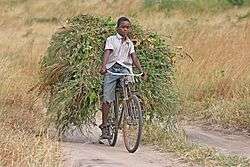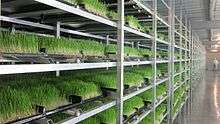Fodder
Fodder, a type of animal feed, is any agricultural foodstuff used specifically to feed domesticated livestock, such as cattle, rabbits, sheep, horses, chickens and pigs. "Fodder" refers particularly to food given to the animals (including plants cut and carried to them), rather than that which they forage for themselves (called forage). Fodder (/ˈfɒdər/) is also called provender (/ˈprɒvəndər/) and includes hay, straw, silage, compressed and pelleted feeds, oils and mixed rations, and sprouted grains and legumes (such as bean sprouts, fresh malt, or spent malt). Most animal feed is from plants, but some manufacturers add ingredients to processed feeds that are of animal origin.

The worldwide animal feed industry produced 873 million tons of feed (compound feed equivalent) in 2011,[1] fast approaching 1 billion tonnes according to the International Feed Industry Federation,[2] with an annual growth rate of about 2%. The use of agricultural land to grow feed rather than human food can be controversial; some types of feed, such as corn (maize), can also serve as human food; those that cannot, such as grassland grass, may be grown on land that can be used for crops consumed by humans. In many cases the production of grass for cattle fodder is a valuable intercrop between crops for human consumption, because it builds the organic matter in the soil. When evaluating if this soil organic matter increase mitigates climate change, both permanency of the added organic matter as well as emissions produced during use of the fodder product have to be taken into account. Some agricultural byproducts fed to animals may be considered unsavory by human consumers.
Common plants specifically grown for fodder



- Alfalfa (lucerne)
- Barley
- Common duckweed[3]
- Birdsfoot trefoil
- Brassica spp.
- Clover
- Alsike clover
- Red clover
- Subterranean clover
- White clover
- Grass
- Bermuda grass
- Brome
- False oat grass
- Fescue
- Heath grass
- Meadow grasses (from naturally mixed grassland swards)
- Orchard grass
- Ryegrass
- Timothy-grass
- Corn (maize)
- Millet
- Oats
- Sorghum
- Soybeans
- Trees (pollard tree shoots for "tree-hay")
- Wheat
Types of fodder
- Biochar for cattle[4]
- Bran
- Conserved forage plants: hay and silage
- Compound feed and premixes, often called pellets, nuts or (cattle) cake
- Crop residues: stover, copra, straw, chaff, sugar beet waste
- Fish meal
- Freshly cut grass and other forage plants
- Grass/lawn clipping waste[5]
- Green maize
- Green sorghum
- Horse gram
- Leaves from certain species of trees [6]
- Meat and bone meal (now illegal in cattle and sheep feeds in many areas due to risk of BSE)
- Molasses
- Native green grass
- Oilseed press cake (cottonseed, safflower, sunflower, soybean, peanut or groundnut)
- Oligosaccharides
- Processed insects (i.e. processed maggots[7])
- Seaweed (including Asparagopsis taxiformis which is used mainly as a supplement to reduce methane emissions by up to 90%)
- Seeds and grains, either whole or prepared by crushing, milling, etc.
- Single cell protein[8](can also be made from atmospheric CO2)
- Sprouted grains and legumes
- Yeast extract (brewer's yeast residue)
Health concerns
In the past, bovine spongiform encephalopathy (BSE or "mad cow disease") spread through the inclusion of ruminant meat and bone meal in cattle feed due to prion contamination. This practice is now banned in most countries where it has occurred. Some animals have a lower tolerance for spoiled or moldy fodder than others, and certain types of molds, toxins, or poisonous weeds inadvertently mixed into a feed source may cause economic losses due to sickness or death of the animals. The US Dept. of Health and Human Services regulates drugs of the Veterinary Feed Directive type that can be present within commercial livestock feed.
Drought Emergency Fodder
Increasing intensities and frequencies of drought events, put rangeland agriculture under pressure in semi-arid and arid geographic areas. Innovative emergency fodder production concepts have been reported, such as bush-based animal fodder production in Namibia. During extended dry spells, farmers have turned to using woody biomass fibre from encroacher bush as primary source of cattle feed, adding locally available supplements for nutrients as well as to improve palatability.[9][10][11]
Production of sprouted grains as fodder

Fodder in the form of sprouted cereal grains such as barley, and legumes can be grown in small and large quantities. Hydroponic systems can grow up to tons of sprouts to each day; year round in a carefully controlled environment.[12]
Sprouted grains can increase the nutritional value of the grain compared with feeding the ungerminated grain to stock.[13] In addition, they use less water than traditional forage, making them ideal for drought conditions. Under hydroponic conditions, sprouted fodder at 150 mm tall with a 50 mm root mat is at its peak for animal feed. Although products, such as barley, are grain, when sprouted they are approved by the American Grassfed Association to be used as livestock feed.
In popular culture
In Starwars, fodder is called poodoo.
See also
- Cannon fodder (metaphorical usage)
- Circular agriculture
- Factory farming
- Feed manufacturing
- Forage
- Grain
- Pasture
References
- "allaboutfeed.net". allaboutfeed.net. allaboutfeed.net. Archived from the original on 13 October 2014. Retrieved 6 October 2014.
- "IFIF". IFIF.org. IFIF. Archived from the original on 14 October 2014. Retrieved 8 October 2014.
- Valorization of agricultural wastewater streams into an alternative protein source duckweed.
- Daly, Jon (18 October 2019). "Poo-eating beetles and charcoal used by WA farmer to combat climate change". ABC.net.au. Australian Broadcasting Corporation.
Mr Pow said his innovative farming system could help livestock producers become more profitable while helping to address the impact of climate change.
- Logsdon, Gene (2004). All Flesh Is Grass. Ohio University: Swallow Press. Chapter 20. ISBN 0-8040-1069-2.
- "Archived copy" (PDF). Archived (PDF) from the original on 2015-09-27. Retrieved 2015-09-22.CS1 maint: archived copy as title (link)
- AgriProtein using food and abattoir waste to farm maggots
- Giec, A; Skupin, J (1988). "Single cell protein as food and feed". Nahrung. 32: 219–29. doi:10.1002/food.19880320302. PMID 3292921.
- Ministry of Agriculture, Water and Forestry (2018). Report on the Bush-to-Feed Pilot Projet in the African Wild Dog Community Forest. http://www.forestry.gov.na/documents/32982/937523/NAFOLA+Report+on+bush/8be204be-eb4f-4156-bac7-610ae9c35315?version=1.0
- "Manual on how to produce animal feed from local encroached bush launched". Namibia Economist. 2020-11-30. Retrieved 2020-06-22.
- "Turning bush to feed in face of drought". The Namibian. 2016-10-18. Retrieved 2020-06-22.
- Sneath, Roger; McIntosh, Felicity (October 2003). Review of Hydroponic Fodder Production for Beef Cattle. www.mla.com.au. Meat & Livestock Australia Limited. ISBN 1740365038. Retrieved 7 June 2018.
Hydroponic sprouts may have profitable application in intensive, small-scale livestock situations with high value outputs, where land and alternative feed costs are high, and where the quality changes (eg less starch, more lysine, vitamins, etc) due to sprouting are advantageous to the particular livestock.
- Sneath, Roger; McIntosh, Felicity (October 2003). Review of Hydroponic Fodder Production for Beef Cattle. www.mla.com.au. Meat & Livestock Australia Limited. p. 15. ISBN 1740365038. Retrieved 7 June 2018.
Further reading
- Zhou, Yiqin. Compar[ison of] Fresh or Ensiled Fodders (e.g., Grass, Legume, Corn) on the Production of Greenhouse Gases Following Enteric Fermentation in Beef Cattle. Rouyn-Noranda, Qué.: Université du Québec en Abitibi-Témiscamingue, 2011. N.B.: Research report.
- Traditional and Innovative Breeding
External links
| Look up fodder in Wiktionary, the free dictionary. |
| Wikimedia Commons has media related to Fodder. |